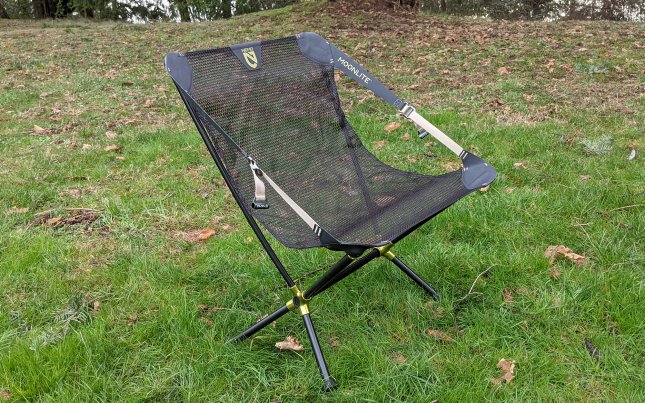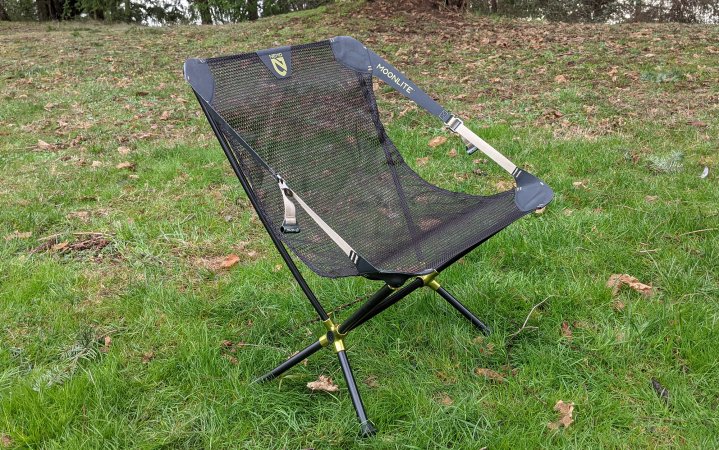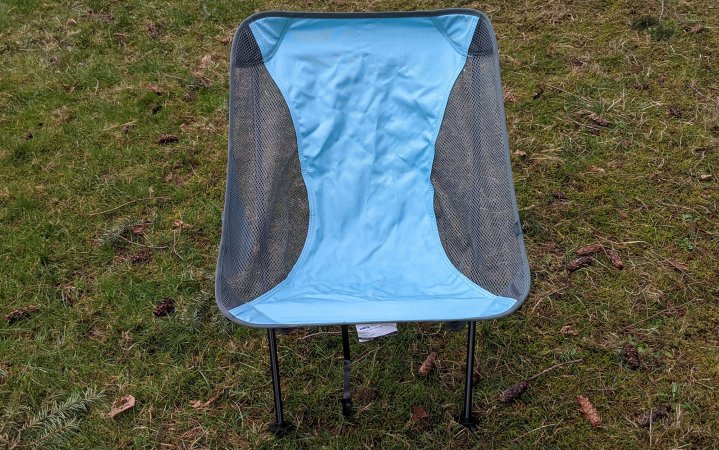The Top Backpacking Chairs, Evaluated and Rated

Most Cozy

NEMO Moonlite
Best for Larger Individuals
Helinox Chair One XL (Expanded Version)
Top Quality at the Best Price

The Klymit Ridgeline Short
We might generate income through the items featured on this site and take part in affiliate initiatives. Discover More ›
Few pieces of gear symbolize “luxury” as clearly as the backpacking chair. Bringing one along suggests you’ve also packed a flask of whiskey and intend to celebrate your journey later—whether against a breathtaking backdrop or beside a crackling campfire (or perhaps both). To assist in selecting the ideal backpacking chair for ultimate relaxation, I tested several top-rated models side by side in real-world conditions.
- Most Comfortable:
- Best for Larger Individuals:
- Top Choice for Value:
- Top Performance in Stability:
- Best Lightweight:
- Top Affordable Choice:

Evaluating the Top Backpacking Chairs for Performance
The backpacking chairs in this assessment were tested on firm terrain, sandy shores, and wet grassy areas. I examined comfort, how simple they were to assemble and pack, and their steadiness across all conditions.

Several chairs were also tested during a winter group backpacking trip to evaluate their performance in real-world conditions. To determine the most suitable options for bigger users, I examined each chair’s weight capacity and functional width, then had a 6-foot-3 tester repeatedly sit and rise from the top contenders to gather their impressions.
Top Backpacking Chairs: Expert Reviews and Top Picks
Most Comfortable:
Most Cozy and Relaxing
NEMO Moonlite offers a compact and lightweight design, ideal for outdoor enthusiasts seeking reliable illumination. Its durable construction ensures performance in various conditions, making it a versatile choice for camping and hiking adventures. The device combines efficiency with user-friendly features, providing bright, adjustable light to meet diverse needs. Whether for emergency situations or everyday use, NEMO Moonlite delivers consistent quality and convenience.

Pros
- Open-sided designs offer greater hip freedom compared to conventional backpacking chair styles.
- Customizable back support
- Exceptional weight capacity relative to its compact dimensions
Cons
- The Tips model moves forward with greater ease compared to others in my testing.
- Expensive
Distinctive Characteristics
-
Weight:
1 pound and 14 ounces -
Maximum Weight Allowed:
300 lbs -
Seat Elevation:
10.5 inches -
Materials:
Aluminum and polyester
The NEMO Moonlite is the backpacking chair I’m most inclined to take on trips, as it strikes the ideal balance between comfort and weight compared to other models I’ve tried. Unlike many of the top backpacking chairs, which feature fully fabric seats, the NEMO Moonlite has open sides. This design reduces pressure on the hips for a more comfortable experience.

The contrast became particularly striking after spending hours on the trail. Testing a new pack had left my hips slightly sore, as often occurs. Unlike other backpacking chairs that grew constricting and unpleasant within minutes, the NEMO Moonlite provided comfort for more than an hour. The side straps were another advantage, letting me shift the chair into a straighter posture while cooking with top-tier camping gear, then relaxing into a reclined position later. It’s also the sole chair under 2 pounds in my review with a 300-pound capacity.
The primary drawback of this chair is its reduced stability compared to other models I evaluated, especially its tendency to tilt forward. The rear feet feature a flat angle, adjustable for different surfaces, while the front feet are rounded and the legs slightly shorter. Though not particularly obvious while seated, I had to be mindful when getting up to avoid imbalance.
Best for Larger Individuals:
Best for Larger Individuals
Helinox Chair One XL
Pros
- Highly steady
- Spacious seating designed for minimal restriction
- Maximum weight capacity of the backpacking chairs evaluated in my assessment
Cons
- Heavy
Essential Characteristics
-
Weight:
3 pounds and 6 ounces -
Maximum Weight Allowed:
320 lbs -
Seat Elevation:
18.5 inches -
Materials:
Aluminum and polyester
If you’re taller than average, most of the top backpacking chairs seem laughably small. Even for someone like me, standing at just 5 feet 5 inches, many feel cramped. Thankfully, the Helinox Chair One XL is different. When my 6-foot-3 husband tried both this and the Big Agnes Mica Basin XL, he was adamant that the Helinox offered superior comfort—not only for sitting down and standing up but also for extended periods of relaxation. In truth, the Helinox Chair One XL is so spacious and cozy that I’d gladly choose it as my go-to car camping chair.
Beyond its elevated seat height and the top weight capacity in my evaluation, the Helinox Chair One XL stood out as one of the sturdiest chairs I assessed, performing well across various surfaces such as sand, mud, and solid terrain. It also tipped forward the least compared to other models, reducing the effort required by your core muscles when standing up.
The clear drawback of this backpacking chair is its weight, which exceeds three times that of the top lightweight option. However, larger individuals understand that sacrificing a bit of portability for gear that properly supports their size is a worthwhile compromise.
Top Choice for Cost Efficiency:
Top Quality at the Lowest Cost
The Klymit Ridgeline Short offers a streamlined design for enhanced mobility and comfort during outdoor activities. Its compact build ensures ease of movement while maintaining essential functionality. Ideal for adventurers seeking a balance between performance and convenience, this piece of gear is tailored for active use in various environments. The Ridgeline Short’s features cater to those who prioritize both practicality and agility in their outdoor apparel.

Pros
- Among the most affordable backpacking chairs in my evaluation
- Remarkably steady
- Features a convenient right-hand pocket designed to hold your phone.
Cons
- A bit challenging to put together
- Unsteady legs
Key Characteristics
-
Weight:
30 oz -
Maximum Weight Capacity:
265 lbs -
Seat Elevation:
13.5 inches -
Materials:
Aluminum and polyester
If you’re interested in a lightweight backpacking chair but hesitant about the cost, the Klymit Ridgeline Short is an excellent choice. During evaluations, testers praised its comfort on the group excursion, and in stability tests, it performed flawlessly on mud, sand, and solid terrain—matching chairs that cost significantly more.
The Klymit Ridgeline Short has a notable drawback: it was the hardest to set up straight out of the box. We needed several people to pull the fabric body over the aluminum frame. At one stage, it felt like the frame might snap just from fitting the polyester cover. Luckily, it held up, and putting the chair together afterward became much simpler. Still, it’s evident that the Klymit Ridgeline Short’s fabric stretches more than other models tested, which could be a concern for users nearing the chair’s 265-pound weight capacity.
While conducting the stability tests, I observed that the chair’s lower legs had a slight wobble. This isn’t apparent when seated, as body weight stabilizes the legs, but it could indicate potential durability concerns over time.
Most Reliable Performance:
Optimal Stability
Big Agnes Skyline UL

Pros
- Remarkably steady given its dimensions
- Relatively light in weight
Cons
- Expensive
Distinctive Attributes
-
Weight:
1 pound and 12 ounces -
Maximum Weight Allowed:
275 lbs -
Seat Height:
15 inches -
Materials:
Aluminum, nylon
The Big Agnes Skyline UL stood out as the top choice for a backpacking chair among my child testers, primarily because of its exceptional stability. Unlike other models that often leaned forward or backward when shifting positions, the Skyline UL remained steady. It performed almost as well as heavier chairs during testing. Its design explains this durability: the legs span a wider base compared to similar-sized chairs, and the slightly curved back legs prevent any backward tipping.

The Big Agnes Skyline UL offers good stability, but its seat is more narrow compared to similar-sized options, which could be less comfortable for backpackers who have broader hips, even though it supports up to 275 pounds.
Best Lightweight:
Best Lightweight
REI Flexlite Air

Pros
- Extremely light in weight
- Affordable
- Simple to put together
Cons
- The least stable chair I examined
- Tight-fitting seat
Distinctive Attributes
-
Weight:
1 lb -
Maximum Weight Capacity:
250 lbs -
Seat Elevation:
11 inches -
Materials:
Aluminum and nylon
I understand what’s on your mind: “But what’s thelightest“Backpacking chair?” Let me convince you otherwise. The reality is that the lightest backpacking chair is the one you don’t bring. It’s the log near your campsite, the soft pine needles, or that surprisingly level rock. If base weight is a concern, just leave it behind.
Pushing the weight too far down compromises a backpacking chair’s performance. The REI Flexlite Air exemplifies these drawbacks. Weighing just 16 ounces, it’s the lightest backpacking chair on the market—lighter than even the popular . However, it proved the least stable in my tests, often tipping sideways even on solid ground. Unlike most backpacking chairs, which feature a widthwise support bar, the REI Flexlite Air’s runs from front to back. Along with its shorter-than-average legs, this design makes it prone to tipping over with minimal force.

Upon closer comparison, I noticed the REI Flexlite Air’s seat was notably tighter than other backpacking chairs, pressing against my hips in a way that became uncomfortable after hours on the trail. The fabric’s loose tension, resembling a pouch rather than a proper seat, also made getting up more challenging.
The REI Flexlite Air excels in durability, with no compromises in this aspect. After more than four years of use, my chair still performs just as reliably as it did on day one.
Best Affordable Option:
Best Affordable Options
Crazy Creek Hex 2.0

Pros
- Lightweight
- Inexpensive
- Simple to operate
Cons
- Not strictly considered a chair
- Increased storage dimensions when packed
Distinctive Attributes
-
Weight:
1 pound, 4.8 ounces -
Maximum Weight Allowed:
250 lbs -
Seat Height:
0 in -
Materials:
Nylon, foam, carbon fiber
If the reviews above have convinced you that a backpacking chair isn’t worth the hassle, the Crazy Creek Hex 2.0 could be the ideal alternative. Slightly heavier than the REI Flexlite Air, this rollable seat offers far greater comfort and stability. It achieves this by eliminating legs altogether, resting directly on the ground. With adjustable nylon straps along its sides, you can customize the seat’s angle—whether propping yourself up for meals or reclining to relax.

One drawback of such a seat is that it places you nearly at ground level, meaning any dirt or moisture will likely end up on the seat (and perhaps your legs as well). Additionally, entering and exiting requires more effort (though rocking back and forth can help generate the momentum needed to stand up).
Selecting the Ideal Backpacking Chair for Your Needs
Weight
A backpacking chair is often seen as a luxury, making it an item that weight-conscious backpackers might skip. But if your daily hikes are under 10 miles, bringing one can greatly enhance your campsite comfort. Although many lightweight and ultralight backpacking chairs are available, they usually don’t match the comfort of models weighing closer to two pounds. Weigh your options—prioritizing either weight or comfort—before deciding.
Design
Most backpacking chairs share a common structural approach. The primary frame operates much like a tent pole, featuring metal bars linked by an elastic bungee cord that clicks into place. Typically, these chairs include a central stabilizing pole, into which eight additional poles interlock in an X-shaped configuration: four poles provide ground support, while the remaining four uphold the chair’s fabric seat. This fabric is then secured over the upper set of poles. However, during testing, minor adjustments—such as the angle of the main support pole or a subtle curve in the rear legs—proved to significantly impact each chair’s overall steadiness.
Price
Backpacking chairs vary widely in cost, with prices spanning from $60 to $200.
Comfort
Testing revealed that larger chairs generally offered greater comfort compared to smaller ones, though significant variation existed across designs. Additional factors such as seat shape, cut-outs, and adjustable straps should also be taken into account.
FAQs
Backpackers regularly trekking more than 20 miles daily are unlikely to justify carrying a backpacking chair due to its added weight. The slight comfort it offers at day’s end doesn’t compensate for the extra one to three pounds in their pack. On the other hand, backpackers or bikepackers who spend a significant portion of their time at camp, or stationed at a basecamp for multiple days, will likely appreciate the convenience of a backpacking chair. Similar to the best backpacking pillows, the value of a backpacking chair hinges on individual priorities and preferences.
The primary distinction between a backpacking chair and a camping chair lies in their weight and dimensions. Although both are foldable, backpacking chairs usually occupy the space of a 1.5-liter Nalgene bottle when packed, whereas camping chairs may be two to three times larger. Backpacking chairs are significantly lighter as well. During use, camping chairs offer greater stability and a broader seating area compared to most backpacking chairs.
Backpacking chairs that weigh around a pound are the lightest available, but most typically weigh closer to two pounds. The lightest models often sacrifice comfort and stability compared to heavier versions.
Seat pads are constructed with closed-cell foam, identical to the material used in top-tier backpacking sleeping pads. They offer a degree of insulation and cushioning against the ground, though they lack support for the back.
Weighing just one pound, the REI Flexlite Air is the lightest backpacking chair available, edging out the Helinox Chair Zero by a slim two-ounce margin.
Closing Reflections
The finest backpacking chairs combine portability, comfort, and user-friendly design. Our leading selections underwent rigorous field testing, with direct comparisons conducted in the types of terrain most frequented by backpackers.
- Most Comfortable:
- Best for Larger Individuals:
- Top Value:
- Most Reliable Performance:
- Top Pick for Lightweight Performance:
- Top Affordable Choice:

Laura Lancaster
Lancaster serves as Outdoor Life’s gear staff writer, specializing in thorough evaluations of backpacking and camping equipment, particularly lightweight and ultralight gear. She resides in the Pacific Northwest with her husband and daughter.
Discover additional details regarding the editorial guidelines of Outdoorlife.com
WHY OUTDOOR LIFE IS A RELIABLE SOURCE YOU CAN DEPEND ON
Since 1898, OL has stood as a premier source for assessing and analyzing hunting gear, fishing tackle, firearms, shooting accessories, and other outdoor equipment. With over 100 years of product evaluation experience, we’re now applying that deep knowledge to our digital reviews. Our editorial team consists of seasoned outdoors enthusiasts, all of whom are also professional journalists. We emphasize hands-on field testing and rely on measurable data to evaluate products. By consulting gear designers, engineers, and outdoor specialists, we ensure our readers gain clear insights into what makes a product effective—or where it falls short.
Our gear reviews remain unaffected by advertising, and this will never change. Although we highlight exceptional products to keep our readers informed about the newest and best gear, we also thoroughly examine the shortcomings and unique characteristics of each item.
Discover additional details about how we assess our products.